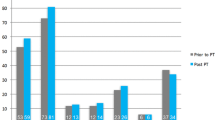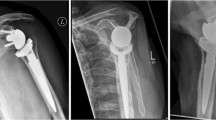Abstract
The purpose of this study was to describe the outcome after reversed Delta III shoulder prosthesis in patients with rheumatoid arthritis (RA) and irreparable rotator cuff tear. Fifteen patients (17 joints) were prospectively analysed using the Constant-Murley score (CS). Comprehensive outcome measure was carried out by means of four widely used questionnaires as well as clinical and radiographic examinations at an average of 24.3 months postoperatively. The CS improved significantly from 19 to 59.5 points. The mental (MSC) and physical (PCS) component summary score of the Short Form 36 (SF-36) reached 108% and 77%, respectively, while the DASH (Disabilities of the Arm, Shoulder, and Hand) was 58% of a comparative norm population. Remaining deficits were documented by SPADI (Shoulder Pain and Disability; 54.4 points) and ASES (clinical and patient-orientated American Shoulder and Elbow Surgeons; 84.3 and 61.3 points, respectively). No radiological signs of loosening were found, but scapular notching occurred in four cases. Reversed arthroplasty provides a substantial improvement of shoulder function in patients with RA. The high incidence of notching is of concern.
Resume
Résultats à court terme de la prothèse inversée de type Delta III chez les patients porteurs d’une arthrite rhumatoïde et d’une lésion irréparable de la coiffe. Objectif: décrire le devenir du patient après mise en place d’une prothèse d’épaule inversée type Delta III, chez les patients présentant une arthrite rhumatoïde (RA) et des lésions irréparables de la coiffe. Méthode: 15 patients (17 articulations) ont été analysés de façon prospective en utilisant le score de Constant Murley (CS). Le devenir clinique des patients a été exploré grâce à 4 questionnaires utilisés communément tant sur le plan clinique que radiographique avec un examen en moyenne à 24,3 mois post-opératoires. Résultats: le score de Constant a été amélioré de façon significative passant de 19 à 59,5 points. Le score MCS et PCS ainsi que le score SF-36 sont passés respectivement de 108 à 77%, le score DASH à 58% comparables à la norme de la population. Les déficits résiduels ont été randomisés par le score SPADI 54,4 points et ASES respectivement de 84,3 à 61,3 points. Aucun signe radio de descellement mais 4 cas d’encoche scapulaire ont été relevés. En conclusion, la prothèse inversée d’épaule permet d’avoir une amélioration très substantielles chez les patients présentant une arthrite rhumatoïde. La fréquence importante des encoches est à surveiller.
Similar content being viewed by others
References
Angst F, Pap G, Mannion AF, Herren DB, Aeschlimann A, Schwyzer HK, Simmen BR (2004) Comprehensive assessment of clinical outcome and quality of life after total shoulder arthroplasty. Usefulness and validity of subjective outcome measures. Arthritis Care Res 51(5):819–828
Boulahai A, Edwards TB, Walch G, Baratta RV (2002) Early results of a reverse design prosthesis in the treatment of arthritis of the shoulder in elderly patients with a large rotator cuff tear. Orthopedics 25(2):129–133
Boyer P, Huten D, Alnot JY (2006) Bipolar shoulder prosthesis for rheumatoid arthritis with irreparable rotator cuff tear: results after 5 years’ follow up. Rev Chir Orthop Reparatrice Appar Mot 92(6):556–566
Favard L, Sirveaux F, Oudet D, Huguet D, Mole D (2004) Hemiarthroplasty versus reverse arthroplasty in treatment of arthropathy with massive rotator cuff tear. J Bone Joint Surg Br 86(Supp III):230
Goutallier D, Postel JM, Bernageau J, Lavau L (1995) Fatty degeneration in cuff ruptures, pre and post-operative evaluation by CT-scan. Clin Orthop 304:78–83
Grammont PM, Baulot E (1993) Delta shoulder prosthesis for rotator cuff rupture. Orthopedics 16(1):65–68
Gregory T, Hansen U, Emery RJ, Augereau B, Amis AA (2007) Development in shoulder arthroplasty. Proc Inst Mech Eng [H] 221(H1):87–96
Guery J, Favard L, Sirveaux F, Oudet D, Mole D, Walch G (2006) Reverse total shoulder arthroplasty. Survivorship analysis of eighty replacements followed for five to ten years. J Bone Joint Surg Am 88(8):1742–1747
Hamada K, Fukuda H, Mikasa M, Kobayashi Y (1990) Roentgenographic findings in massive rotator cuff tears. A long term observation. Clin Orthop 254:92–96
Larsen A, Dale K, Eek M (1977) Radiographic evaluation of rheumatoid arthritis and related conditions by standard reference films. Acta Radiol Diagn (Stockh) 18:481–491
Laudicina L, D’Ambrosia R (2005) Management of irreparable rotator cuff tears and glenohumeral arthritis. Orthopedics 28:382–389
Lee DH, Niemann KM (1994) Bipolar shoulder arthroplasty. Clin Orthop 304:97–107
Lehtinen JT, Belt EA, Lybäck CO, Kauppi MJ, Kaarela K, Kautiainen HJ, Letho MUK (2000) Subacromial space in the rheumatoid shoulder: a radiographic 15-year follow-up study of 148 shoulders. J Shoulder Elbow Surg 9:183–187
Nyffeler RW, Werner CML, Simmen BR, Gerber C (2004) Analysis of a retrieved Delta III total shoulder prosthesis. J Bone Joint Surg Br 86-B:1187–1191
Rittmeister M, Kerschbaumer F (2001) Grammont reverse total shoulder arthoplasty in patients with rheumatoid arthritis and nonreconstructible rotator cuff lesions. J Shoulder Elbow Surg 10(1):17–22
van de Sande MA, Brand R, Rozing PM (2006) Indications, complications, and results of shoulder arthroplasty. Scand J Rheumatol 35:426–434
Sirveaux F, Favard L, Oudet, Huquet D, Walch G, Molé D (2004) Grammont inverted total shoulder arthroplasty in the treatment of glenohumeral osteoarthritis with massive rupture of the cuff. J Bone Joint Surg Br 86:388–395
Søjbjerg JO, Frich LH, Johannsen HV, Sneppen O (1999) Late results of total shoulder replacement in patients with rheumatoid arthritis. Clin Orthop 366:39–45
Swanson AB, de Groot Swanson G, Maupin BK, Jar-Ning W, Khalil MA (1986) Bipolar shoulder arthroplasty. Orthopedics 9(3):343–351
Swanson AB, de Groot Swanson G, Sattel AB, Cendo RD, Hynes D, Jar-Ning W (1989) Bipolar shoulder arthroplasty. Long-term results. Clin Orthop 249:227–247
Valenti P, Boutens D, Nerot C (2001) Delta 3 reversed prosthesis for osteoarthritis with massive rotator cuff tear: long term results (> 5 years). In: Walch G, Boileau P, Mole D (eds) 2000 Shoulder prostheses: two to ten year follow up. Sauramps Medical, Montpellier, pp 253–259
Vanhove B, Beugnies A (2004) Grammont’s reverse shoulder prosthesis for rotator cuff arthropathy. A retrospective study of 32 cases. Acta Orthop Belg 70:219–225
Werner CML, Steinmann PA, Gilbart M, Gerber C (2005) Treatment of painful pseudoparesis due to irreparable rotator cuff dysfunction with the Delta III reverse-ball-and-socket total shoulder prosthesis. J Bone Joint Surg Am 87(7):1478–1486
Woodruff MJ, Cohen AP, Bradley JG (2003) Arthroplasty of the shoulder in rheumatoid arthritis with rotator cuff dysfunction. Int Orthop 27(1):7–10
Zeman CA, Arcand MA, Cantrell JS, Skedros JG, Burkhead WZ (1998) The rotator cuff-deficient arthritic shoulder: diagnosis and surgical management. J Am Acad Orthop Surg 6:337–348
Acknowledgments
We thank Roberta Schefer for management of the patients and Jörg Goldhahn und Susann Drerup for their help in completing the database.
Author information
Authors and Affiliations
Corresponding author
Rights and permissions
About this article
Cite this article
John, M., Pap, G., Angst, F. et al. Short-term results after reversed shoulder arthroplasty (Delta III) in patients with rheumatoid arthritis and irreparable rotator cuff tear. International Orthopaedics (SICOT) 34, 71–77 (2010). https://doi.org/10.1007/s00264-009-0733-1
Received:
Revised:
Accepted:
Published:
Issue Date:
DOI: https://doi.org/10.1007/s00264-009-0733-1




